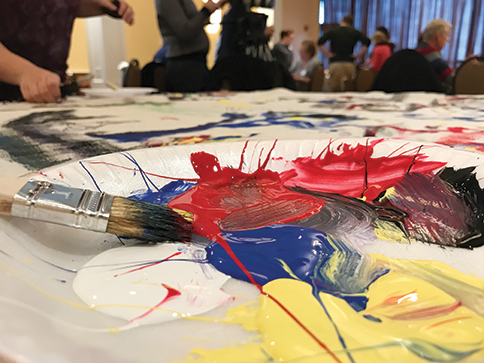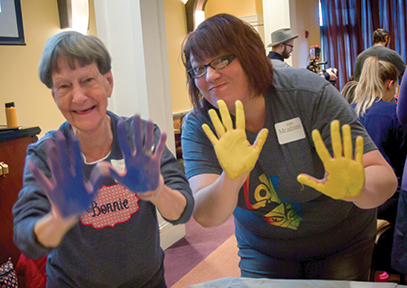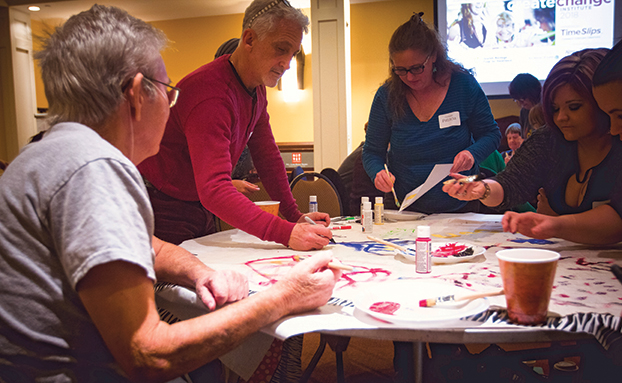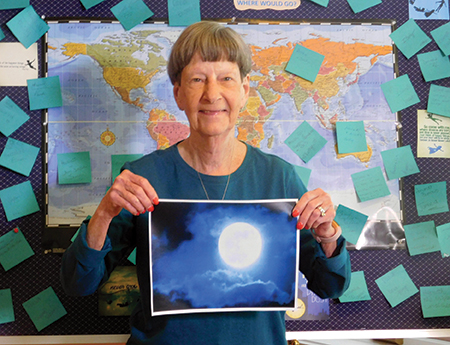A transformation is happening in Kentucky. Residents, staff, family members, and volunteers for 12 rural nursing centers are teaming up with professional artists and producers to embrace creativity and all the benefits it brings.

Through the performing arts, painting, music, and other mediums, these centers are reinventing themselves by shaping their facilities into creative cultural centers, places open to the public where anyone can come and observe the wonders and beauty of art.
A New Partnership
It’s all part of the “I Won’t Grow Up” project, a partnership between Signature HealthCARE, a long term and post-acute care (LT/PAC) provider with 117 locations across the country, and TimeSlips, a nonprofit organization that infuses creativity into care relationships and systems. The project is funded by a civil money penalty grant through the Kentucky Office of Inspector General, the Centers for Medicare & Medicaid Services, and the National Endowment for the Arts.
Anne Basting is founder of TimeSlips and professor of theatre at the University of Wisconsin Milwaukee Peck School of the Arts. She says that, while common activities in LT/PAC are focused mostly on the residents, the “I Won’t Grow Up” project takes this thinking a step further by asking: What if?
“What if programming in care settings were so interesting that families wanted to come and do it with the elder?” she says. “And staff wanted to participate, too? That it could be a meeting ground for people and a relationship and community-building ground for the organization.” The efforts around such a program would be for mutual growth, rather than an intervention for the elder only, she says.
What If
“What if nursing centers became more than what they are today is the question on everyone’s mind,” says Angie McAllister, Signature’s director of culture change.
For the “I Won’t Grow Up” project, the concept of What If extends to partnerships that likely would not be taking place otherwise, including those in the art world.

Signature’s partner includes a national and regional team of artists with Basting as the lead. Another team includes a choreographer from Chicago, a set designer from New Orleans, and a production manager from Chicago. The artists are focused on empowering residents, staff, and others to live out their creative potential, with the end goal of reopening their doors as creative cultural centers in 2019. The centers will each choose which art will be on display.
The topic is a retelling of the story of Peter Pan. “The thing about Peter Pan is that it really does cross all generations,” says McAllister. “All cultures identify with Peter Pan and with aging. It seemed to us, wow this was a no brainer, and how do we take this theme and really start to engage people?”
You Can Fly
One way is by exploring the concept of flying, says McAllister. Staff put up a map and asked residents where they wanted to fly to, and marked it. “So once residents got started, you’d see staff coming in and putting up on the board where they would want to fly to. And then you have visitors that come in to the nursing center and say, ‘Oh this is cool, what are you doing? I want to do this. I want to fly here.’ People just naturally become part of it.”
The next step would include participants taking all those ideas and starting to paint them or create other things around where they want to fly to, she says. This step could include a performing arts piece, or an art installation piece, for example, that would be on display at the center. Or, if the residents decided to make a play, members of the community could come see it live.
“There’s no limitations on it for the residents to participate,” says McAllister. “For example, if there’s a resident that can’t leave their bed but they want to come see it, we’ll move their bed so that they can.”
It Starts With Training
To get all employees on the same page, they receive training. During January through April, all employees receive TimeSlips storytelling methods. They also learn facilitation methods.
Misty Montgomery, quality of life director at Signature HealthCARE Heritage Hall in Lawrenceburg, Ky., remembers it well. “We learned about the different kind of arts that we’re going to be doing,” she says. “It was a creative arts institute two-day training. Some of our elders got to come and engage with us. They loved it. It made their day to go. They felt really good about getting involved with it.”

When residents engaged in the map activity at Heritage Hall, it brought back memories. One resident said he wanted to fly to Germany. “That was the first week, and we didn’t ask why,” says Montgomery. “The second week, I printed out a picture of Germany and gave it to him. And we watched a video. I said, ‘So why would you go to Germany?’ and he said he served in the army there for three years and he would love to fly back and see what it looked like.”
His comment had a ripple effect on the other residents, who imagined what a trip to Germany would look like. “They even got into what they would see on the way there,” says Montgomery.
The staff and residents at Heritage Hall embraced the new way of doing things, she says. “The first part was really about getting them excited to be doing something different. And we hadn’t done it this way before—starting something one day and then a few weeks later we do something else. And then in the future we will do some art. Someone donated a lot of National Geographic magazines, and we’re going to make a collage with this.”
Changing Minds
When asked about the best part of the program so far, Montgomery says it’s seeing the residents open up and step out of their comfort zones. Montgomery recalls one resident who never participated in creative arts. “But there’s a photo of her where she has paint all over her hands and she’s smiling and having fun,” she says. “It’s really great to see her engaging in creative arts because she always says, ‘I’m not creative.’”
Reversing that mentality is a critical part of the “I Won’t Grow Up” program. “We’re trying to make it as simple as possible for people to do this, because I think somewhere along the line, people have been told that they’re not creative,” says Basting.
“And I think part of what we do is encourage people to have the confidence in their own creativity. And to know that creative organizations are flexible organizations, organizations that grow. And so by unleashing and encouraging the creativity of your staff and residents, you’re investing in the success of your organization as well.”
Making Their Mark
As Signature centers are making headway during year one of the “I Won’t Grow Up” program, the future looks to be buzzing with activity. Next year the creative cultural centers open in the summer, and in the third year, the staff and partners will attend a retreat to measure the impact of the program overall. This will be a tool for Signature’s centers in the future, when festivals have concluded.
“Next time, they’ll know how to do it themselves, and they have the relationships with the artists who are also trained in their regions,” says Basting. “So it’s designed to be sustainable for them because I can come with lots of ideas for projects, but so could they.”

She cites one example of a center that, seven years after Basting and her team worked to professionally produce a play for a paying audience, put on a new play that was staged in collaboration with university students. The play was written by the center’s elders. “It had a huge audience, and it was gorgeous and just a beautiful story. And that was seven years later,” she says.
“I think sometimes people think, ‘We already have an arts program, we do water color,’” says Basting. “It’s not what we’re talking about. We’re about really changing the way you think about programming and unleashing creativity in an immersive way. Remember, you are an instigator and a maker of culture at your organization, and people are drawn to you for that reason.”